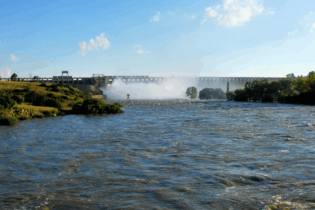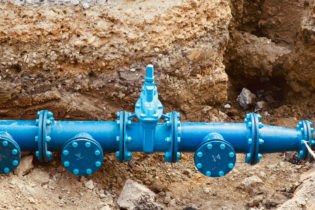During the recent drought in Cape Town, diverse opinions were expressed regarding the underlying reasons why the city found itself hurtling towards the so-called “Day Zero”.
By Dr V Jonker |Aurecon Although the debate was often characterised by negative undertones, a positive outcome was the heightened awareness (perhaps for the first time in many spheres) regarding the economic, social and political value of water. Regrettably, there is a general perception that water resources planning and management in Cape Town, and South Africa, fall significantly short. This is ironic when one considers that since the 1980s, South African water resources engineers and scientists have been at the forefront of developing advanced tools and concepts to support decision making in integrated water resources planning and management. To provide the context, it is useful to consider some of the principles which underlie water resources management. First of all, it is important to note that the volume of water on earth, in all its forms, is constant and the world cannot “run out of water”. However, a critical consideration concerns the spatial and temporal variability of water – and especially how this is impacted by climate change. Secondly, the consistent and significant increase in the demand for water, globally, introduces unique challenges when it comes to the management of water resources. This increase is brought about by population growth – more people need more food, improved living standards, the mining and processing of more minerals, the production of more electricity etc. Food production, specifically, is extremely water intensive with agriculture constituting about 70% of global water use. The above is, of course, also relevant to South Africa. However, the management of our water resources is further complicated by the fact that we are indeed a water scarce country. To put our available water resources into perspective: the mean annual surface water runoff in all our rivers, under natural conditions i.e. without any human impacts, equals more or less 50 billion cubic meters per year – with the natural mean annual runoff in our largest river system, the Vaal-Orange, about 11 billion cubic meters per year. This seems like a lot of water, until we compare it to the mean annual runoff in the Zambezi and Congo rivers for example, which equals 94 and 1 260 billion cubic meters per year respectively. Furthermore, almost 60% of South Africa’s surface water runoff is generated from only 20% of our land surface area, while most of our rivers are also highly seasonal. Another challenge related to water resources management in South Africa, relates to the fact that the water demands of many of our major urban centres exceed the water availability in their immediate vicinity. This necessitated the implementation of complex bulk, integrated storage and water supply systems – often involving elaborate, even transboundary, transfer schemes. An example is the Integrated Vaal River Water Supply System, which supplies almost 12 million people in the Greater Johannesburg / Tshwane area, numerous industries and power stations on the highveld as well as large irrigations schemes further downstream. This system entails the augmentation of water in the Vaal River from adjacent catchments such as the Thukela, Senqu, Usuthu and Incomati rivers and includes various large dams with a total storage capacity of 11 billion cubic metres. Similarly, the Western Cape Water Supply System, which supplies Cape Town, urban areas in the Boland and along the West Coast as well as major irrigators, entails an integrated system and the transfer of large volumes of water from the Berg, Steenbras, Breede and Palmiet catchments over many kilometres via tunnels and pipelines. The Algoa (Port Elizabeth) and some of the other water supply systems are of similar type, though at a smaller scale.During the conceptualisation and construction of the initial phases of these integrated water supply systems in the 1970s and 1980s, the engineers in the then Department of Water Affairs and Forestry (the current Department of Water and Sanitation), realised the need for a new way of thinking regarding the management and optimal operation of these systems.
Suddenly, water resources managers were confronted with decision making which involved highly complex and integrated water supply systems, often spanning across different climatic and hydrological zones, entailing expensive pumping and transfer schemes and supplying a diverse range of user categories: urban domestic and industrial, rural, agriculture and mining, as well as strategic users such as power stations and petrochemical industries. In order to address these challenges, sophisticated system models were developed by the Department in conjunction with some of the country’s foremost consulting engineering firms and academic institutions. These models, which incorporated advanced network solvers specifically designed to analyse complex water supply networks, were supported by state-of-the-art hydrological research at South African institutions. The outcome was South African developed system analysis tools which soon gained international recognition as decision support tools for water resources planning and management of large integrated systems. An innovative feature of the system analysis approach relates to the distinction which is made between the risk profiles of different user categories in the same water supply system in terms of assurance of water supply. Typically, a specific volume of water is allocated to each user. However, proportions of this volume are allocated at different supply reliabilities. High assurance users or volumes allocated at a high assurance of supply, are guaranteed to have a low probability of curtailment during droughts, whereas low assurance users accept a lower supply reliability, i.e. more frequent and more severe water restrictions. The assurance of water supply is typically reflected in the water tariffs. Depending on the outcome of the analyses, decisions are then made regarding the need for, the prioritisation of, and the phasing of augmentation schemes to ensure compliance with the agreed water user risks and allocation volumes, taking into account the projected increase in water demands. The analysis results are also used to guide decision making related to water restrictions. Furthermore, probabilistic projections of future dam storage trajectories provide a useful backdrop for monitoring and tracking actual system storage and serve as an early warning system for the onset of drought. Although the hydrological models and system analysis tools have been refined and modernised over time, they currently still play a key role in the planning and management of large integrated water supply systems in South Africa. Under the guidance of the Department of Water and Sanitation, most of the large, integrated water supply systems in the country are analysed at least once per year. Typically, different scenarios with regard to projected water demands, the state of infrastructure, operating rules and the phasing in of new schemes are analysed. Results are presented and discussed with key stakeholders and collaborative decisions are made with regard to how the system will be operated in the coming year. This brief background regarding water resources management in South Africa confirms that we do have the necessary engineering skills, tools and know-how to effectively manage our water resources. However, as with many engineering solutions, the challenge lies with the successful implementation of the technical recommendations, which are most often dictated or at least influenced by institutional, policy, financial and various other realities.







